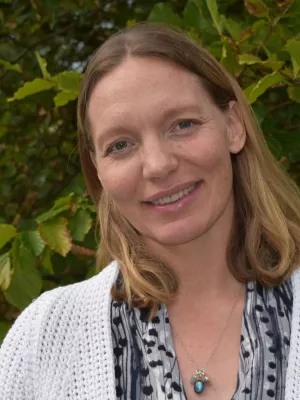
Marianne Hall
Research coordinator

Measuring and modelling stomatal conductance and photosynthesis in mature birch in Sweden
Author
Summary, in English
Stomatal conductance (gs), net photosynthesis (An) and twig water potential (Ct) were measured in mature silver birch (Betula pendula) during 3 years in southern Sweden. Measurements from 2 years were used to parameterise three different gs models and measurements from a 3rd year were used to validate these models. Two different multiplicative stomatal models were used. In one of these, the gs response function for the water vapour pressure deficit (D) was fixed, while in the other the gs sensitivity to D increased with the accumulated time after sunrise with D above a certain threshold value. Furthermore, one combined stomatal-photosynthesis model (L-model) was used. The L-model was run either by using observations of photosynthesis as input data, or by predicting gs and photosynthesis simultaneously from environmental data. The model used to predict photosynthesis was parameterised from measurements of the photosynthetic responses to the photosynthetically active radiation, CO2 and temperature. The stomatal response functions of the L-model were parameterised using observations of
photosynthesis as input data in order to make them independent of the performance of the photosynthesis model. The difference in model performance between the two multiplicative models was relatively small. The multiplicative stomatal models and the L-model were similarly successful in predicting gs when the L-model was driven by observations of photosynthesis. However, the L-model was considerably less successful when photosynthesis was predicted. Photosynthesis was systematically under- and overestimated at high and low Ct, respectively, causing errors in the prediction of gs. In most situations, measurements of photosynthesis are not available and gs must be predicted from environmental data. In such cases, we conclude that the two multiplicative models are more successful in predicting gs in mature silver birch than the combined stomatal-photosynthesis model.
photosynthesis as input data in order to make them independent of the performance of the photosynthesis model. The difference in model performance between the two multiplicative models was relatively small. The multiplicative stomatal models and the L-model were similarly successful in predicting gs when the L-model was driven by observations of photosynthesis. However, the L-model was considerably less successful when photosynthesis was predicted. Photosynthesis was systematically under- and overestimated at high and low Ct, respectively, causing errors in the prediction of gs. In most situations, measurements of photosynthesis are not available and gs must be predicted from environmental data. In such cases, we conclude that the two multiplicative models are more successful in predicting gs in mature silver birch than the combined stomatal-photosynthesis model.
Publishing year
2005
Language
English
Pages
115-131
Publication/Series
Agricultural and Forest Meteorology
Volume
132
Issue
1-2
Links
Document type
Journal article
Publisher
Elsevier
Topic
- Earth and Related Environmental Sciences
Keywords
- stomatal conductance
- photosynthesis
- Betula pendula
- modelling
- water potential
Status
Published
ISBN/ISSN/Other
- ISSN: 1873-2240